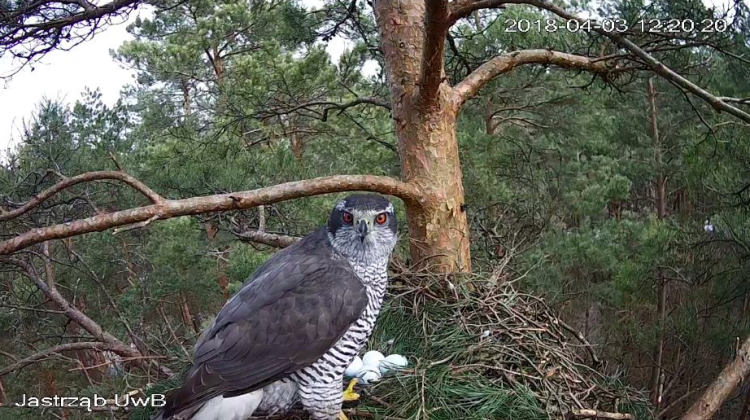Podlaskie/ Watch the hawk`s life online
 Source: University of Bialystok
Source: University of Bialystok
Scientists from the Institute of Biology of the University of Bialystok want to show nature lovers interesting events in the hawks` life. They installed a camera at a nest of these birds in Forest District Dojlidy. Broadcast from the nest can be viewed online.
This is the second such educational project of biologists in Białystok. For the last two seasons, together with Internet users they have watched the life of lesser spotted eagles from Forest District Rudka.
The hawk pair already has eggs in their nest. If everything goes well, they young should hatch in late April, says Dr. Paweł Mirski from the Institute of Biology, University of Bialystok. The female broods four eggs, the male sometimes relieves her, he also brings fresh twigs.
Mirski emphasises that by showing the hawk`s life, scientists also want to change the perception of the species known for hunting for hens and doves. For this reason, hawks are perceived negatively by pigeon breeders, for example. "Winters are difficult for hawks due to limited food, there are only jays and woodpeckers in the forest" - adds Mirski.
He says that hawks are rarely seen due to their hunting strategy. "A hawk will remain hidden somewhere on the forest wall and only venture on a short hunt for birds. That is why we relatively rarely see it" - emphasizes Paweł Mirski. He reminds that the hawk is sometimes called the "spirit of the forest". When looking for a nest for their broadcast, the researchers had to listen for hawks, because it was difficult to spot them.
Paweł Mirski explains that while the hawk has wide distribution in Poland, it is quite rare. It is estimated that there are approx. 4-5 thousand pairs of this species in Poland. Mirski points out that hawks are often confused with other birds, such as the common buzzard (about 50,000 pairs of these birds live in Poland) or the marsh harrier, and people tend to call any predatory bird a hawk.
Female hawk is larger than male, as with all birds of prey - says Mirski and explains that it is called inverted sexual dimorphism. "In hawks this difference is about 40% .This can sometimes be seen on camera. The female is larger, more massive, wider. She has yellow eyes, and the male`s eyes are more orange" - Mirski describes. Male hawk weighs 700-800 grams and the female can be twice as heavy. Dr. Paweł Mirski notes that "the female has the power".
The hawks accepted the presence of the camera quite easily. The broadcast can be viewed here.
PAP - Science in Poland
author: Izabela Próchnicka
kow/ ekr/ kap/
tr. RL
Przed dodaniem komentarza prosimy o zapoznanie z Regulaminem forum serwisu Nauka w Polsce.















